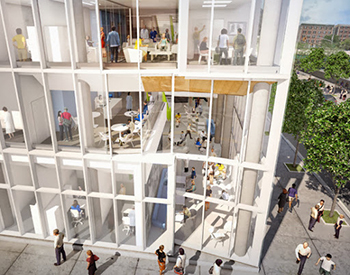Columbia University to Build New Nursing School
 NEW YORK — COFXFOWLE Architects, a joint venture between Los Angeles-based CO Architects and New York-based FXFOWLE, designed a seven-story building for the nursing school at the Columbia University Medical Center campus in New York. Construction is scheduled to begin in mid-summer 2014, with a two-year construction schedule that will allow the building to open in September 2016.
NEW YORK — COFXFOWLE Architects, a joint venture between Los Angeles-based CO Architects and New York-based FXFOWLE, designed a seven-story building for the nursing school at the Columbia University Medical Center campus in New York. Construction is scheduled to begin in mid-summer 2014, with a two-year construction schedule that will allow the building to open in September 2016.
Columbia selected the architectural team through a design competition, which invited five firms to participate. During the competition phase, the university issued a program of their requirements for use in the competition, and the architect designed a building that was based on that program. The site was originally planned to contain a three-story building of 65,000 square feet; however, COFXFOWLE created an alternative approach that included a seven-story building built on half the site. This created a more compact, lower cost and more energy-efficient building while also saving the remaining site for future construction planning.
“We proposed a building that used half the footprint but was twice as high. We used that as a way to create a real presence for the nursing school on the site,” said Guy Geier, FAIA at FXFOWLE. “It also allows for more vertical connectivity. There is an open staircase, which we call ‘the ribbon,’ that winds its way up and connects all floors in a very visible way and really creates a sense of community and continuity between all functions of the building.”
The nursing school needed a new space largely for the simulation labs, Geier said. The school has been operating out of an old facility that was originally built as a residential building renovated to accommodate nursing school functions such as administration office space, student space as well as simulation labs and educational spaces. As the nursing school program grew and expanded, the university realized it needed a new site that would accommodate the needs of the staff and students.
The school’s ground floor includes a gallery, café, student lounge, a large conference room, student services including financial aid and admissions, and a multipurpose community space. The second and third floors provide simulation labs and faculty offices, conference spaces, student study rooms and informal spaces. These labs mimic hospital patient and operating rooms, incorporating responsive mannequins and other education technology that prepare nurses for different real-life situations that occur on the job. Administrative offices and reception and conference areas occupy the fourth floor. The fifth and sixth floors include faculty offices, conference rooms, and breakout and study areas. On the uppermost level is a rooftop terrace to be used as a flexible lounge or study space, as well as used for informal student and faculty gatherings and special events.
“At the heart of this facility was the expressed need to have the highest quality clinical skills and simulation training that the school could find,” said Scott Kelsey, FAIA for CO Architects. “We spent an enormous amount of time working with them to think through that programmatic element. One of the challenges was working with them in developing the program and planning our way through it recognizing that skills and simulation training is a rapidly evolving learning space type.”
Geier said another one of the biggest challenges was managing the needs of the school against the budget. As cost escalation starts to creep back into the marketplace, there’s an ongoing and constant need to manage expectations against the budget, he said. He is “fairly confident” they’re on track in terms of budget because the design team had a cost estimator on board and Columbia hired a construction manager, New York-based TDX Construction Corporation, early enough during schematic design to give input in terms of the selection of materials.
Kelsey added that another issue was trying to think carefully about office space: what’s the right size and how to allocate faculty office space given the fact that space is tight. Geier said the design team worked very closely with faculty to look at their own workspace requirements.
“Most universities and colleges have standards that have been set up historically for faculty offices that are larger than they could be in terms of functionality especially with new furniture systems that are available,” Geier said. “We often find that less space is still very functional. Faculty members are often out of their offices in a lab or some other setting with students. Working with the faculty at the nursing school, we were able to propose a shift into those areas of the program that they were spending time in. It requires a faculty that is more open-minded and that looks at the space requirements more holistically.”
Architecturally, the design has followed the idea that the cladding of the building in part is made of different layers of glass, Kelsey said, and it is designed to achieve LEED Silver certification.
“It’s seen as a beacon and creates a strong identity for the school,” he said. “We’ve designed a lot of health science environments, and there’s been a real desire and development in open and transparent interiors so one can get a sense of everything that’s happening. It’s a very forward-thinking building that puts learning on display.”
